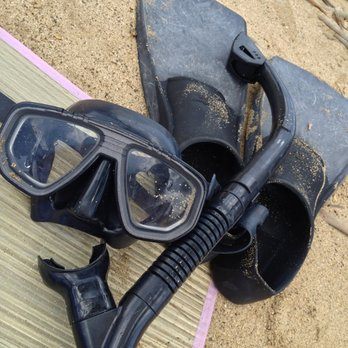Last Updated on July 9, 2024 by Snorkel Ken
 At first glance split fins don’t really look all that impressive. To be honest, they look broke or torn. You would think that, at first glance, split fins wouldn’t do much good in water with the way they wave and flap apart. They look flimsy. And that may be the biggest thing going against split fins; if you don’t do the research and find out that split fins actually work better in most cases and help preserve energy while snorkeling then you may pass them up and opt for less efficient fins.
At first glance split fins don’t really look all that impressive. To be honest, they look broke or torn. You would think that, at first glance, split fins wouldn’t do much good in water with the way they wave and flap apart. They look flimsy. And that may be the biggest thing going against split fins; if you don’t do the research and find out that split fins actually work better in most cases and help preserve energy while snorkeling then you may pass them up and opt for less efficient fins.
Don’t get me wrong, I’m not saying that you need split fins to have an enjoyable snorkeling experience. Far from that, actually. I am actually a large advocate of a good pair of open-heel, adjustable, standard sized fins. In fact, I use this set for most of my personal snorkeling experiences and it works just fine with a completely standard pair of fins.
However, split fins add some awesomeness to your snorkeling experience in many ways:
*They help conserve energy and some studies have shown split fins to be up to 40% more efficient than a regular or long paddle fin.
*Spit fins were develped in the 1990s by a company, Nature’s Wing (R), that does not even manufacture them. They just “invented” and held the patent. By “inventing” I mean that the company studied how the tail fins of dolphins and whales work and then “borrowed” the design. Pretty smaaaaht, actually.
*By kicking with split fins you’re actually doubling up on the amount of resistance into the water and using less kicking power to propel and with less effort in a standard fin. The water, in essence, pushes against itself.
*Since the fins are split they have more movement and fluidity built right into them. This allows all the parts of the fin to actually adapt to the way a person kicks. They form to the wearer’s advantage
*The ability to use smaller kicks in the water, more of a fluttering motion, is great for snorkelers. Less kicking power and effort means less sediment disturbance for a clearer view in the water and the ability to slowly flutter and float around is what a snorkeler is really after because the slower and calmer they are then the more they see.
*Wild motions underwater cause marine life to sometimes act nervously. This slow, gentle type of kicking that splits fins allow should keep most marine life acting mostly natural and allowing the snorkeler to observe more of the natural workings under the water. And, possibly, getting a little closer than usual. Please don’t touch, though.
Disadvantages of Snorkel Split Fins:
From a snorkeling perspective there is no disadvantage with split fins in the performance category. However, because of their design and their purpose to decrease effort and NOT increase speed, then after a certain point of kicking effort a snorkeler’s speed will not increase. Like stated above, snorkelers don’t normally look for speed that some competitive free divers need for that burst.
Lastly, split fins are a bit pricier than your normal paddle fins. While they do decrease effort and work (usually) exactly as they are supposed to, many snorkelers will find those characteristics simply not worth the extra money that split fins cost.
Final Analysis:
If you want them, get them. If you find yourself tiring out too quickly, then split fins may be the right choice for you. If you’re going on a 3 to 7 day snorkeling vacation then an expensive split fin might not be the best choice because of the limited time of use as opposed to the increase price.








